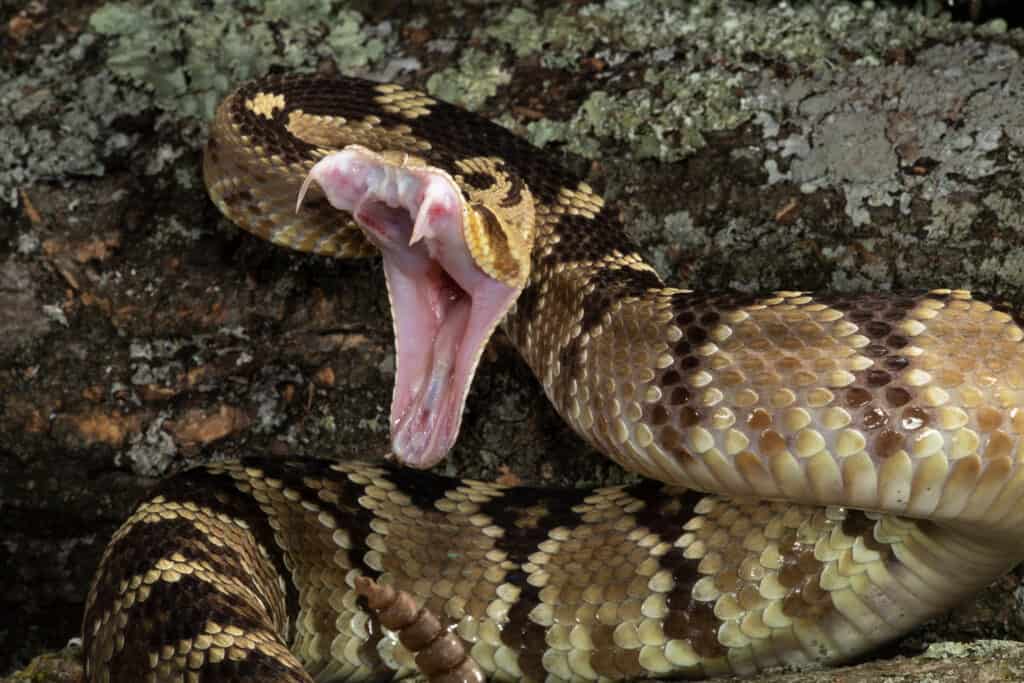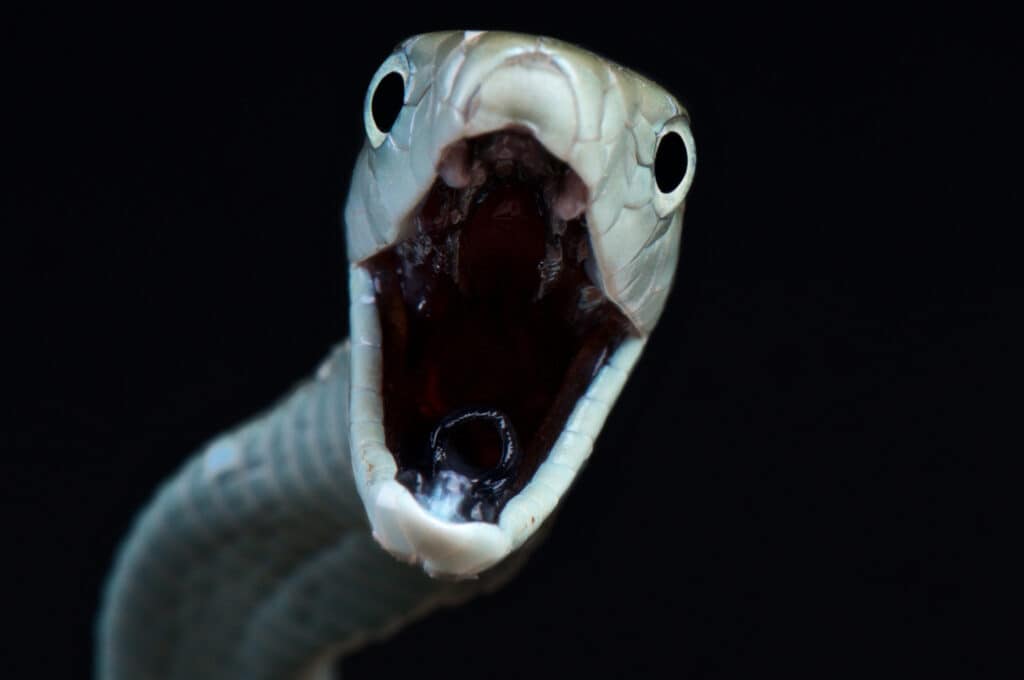What happens if we pit the most dangerous snake in the Americas against the most dangerous snake overall? That’s what we’re going to figure out by examining a black mamba vs. a rattlesnake battle.
The rattlesnake is an iconic venomous reptile that lives in the western hemisphere. It’s a common sight in the Southwestern United States, with about half of all rattlesnake species being found in Arizona alone. Fortunately, good antivenoms and proper medical infrastructure have limited the deaths caused by this snake.
In parts of southern and eastern Africa, the most dangerous snake alive resides. The black mamba isn’t often seen, but its bite has a 100% mortality rate if left untreated. Determining the winner of this battle will require some close examinations of important data!
Comparing a Black Mamba and a Rattlesnake

| Black Mamba | Rattlesnake | |
|---|---|---|
| Size | Weight: 3.5-4.5lbs Length: 6ft-9.5ft, up to 14ft maximum | Weight: 5lbs-10lbs Length: 1.6ft-8ft, depending on species Yet, larger rattlesnakes are possible |
| Speed and Movement Type | – 7-20 mph – 12 mph is probably a more accurate maximum speed | – 2-3 mph – Sidewinder rattlesnakes can reach 18 mph – Timber rattlesnakes have a striking speed of 2.9 meters per second |
| Venom | – Powerful venom that can kill humans quickly – 100g-120g of venom per bite on average with 400g maximum – Capable of killing 10-20 humans with a single bite – 100% envenomation rate and delivers several bites | – May inject as little as 6.5mg to 10mg – Envenomates in 60%-80% of all bites, so there is a fair chance of a dry bite – Strong hemotoxic venom, but not even in the top 10 most powerful venoms |
| Defenses | – A highly aggressive snake that doesn’t back down from a fight – Speed | – Camouflage – The rattling threat display scares many creatures – Ability to slither into small areas to hide |
| Offensive Capabilities | – Capable of raising 40% of its body off the ground to land strikes from far away – Bites several times – Can use its length and weight to wrestle other snakes | – Deadly Venom – Swift striking speed at almost 3 m/s |
| Predatory Behavior | – Ambush predator | – Ambush predator that attacks from cover |
What Are the Key Differences Between a Black Mamba and a Rattlesnake?

Rattlesnakes use hemotoxic venom to kill their prey.
©Alexandree/Shutterstock.com
The key differences between a black mamba and a rattlesnake include their size, venom, and head shape. The black mamba is a long, thin snake that can measure up to 9.5ft and 4.5lbs, possesses a powerful neurotoxic venom, and has a coffin-shaped head, but a rattlesnake has a triangular head, a hemotoxic venom, and grows upwards of 8ft long and 10lbs in weight.
These differences are important to understand, but they do not tell the whole story. We are going to take a closer look at other key factors and get a fuller understanding of this matchup.
What Are the Key Factors in a Fight Between a Black Mamba and a Rattlesnake?

The black mamba, Africa’s most feared snake, is also the world’s fastest snake.
©Andre Coetzer/Shutterstock.com
The biggest factors in any fight are usually size, speed, and offensive powers. That remains the same in this case, but we must also consider unique qualities as well. We’re going to assign advantages in five categories to these snakes and then make our final determination.
Black Mamba vs Rattlesnake: Size
The rattlesnake is heavier but often shorter than the black mamba. The larger black mambas can grow anywhere from 9.5ft to 14ft in length, giving them a length advantage over the rattlesnake. However, rattlesnakes can weigh twice as much as black mambas or more owing to their thicker bodies.
We’re going to call size a draw between these two reptiles in terms of size.
Black Mamba vs Rattlesnake: Speed and Movement
The black mamba is much faster than most rattlesnakes. This snake can move at blazing speeds of between 7-12 mph and supposedly up to 20 mph. The rattlesnake moves at about 3 mph in most cases. The exception is the sidewinder rattlesnake which can move at 18 mph. That’s over short distances, though.
Black mambas have the speed advantage.
Black Mamba vs Rattlesnake: Venom
The black mamba has deadlier venom than the rattlesnake. Black mambas have a neurotoxin that is deadly enough to kill between 10 and 20 humans with a single bite. They inject over 100g of their venom on each bite, and they envenomate with each bite.
Rattlesnakes only envenomate in about 60% to 80% of their bites, and they use a slower-acting hemotoxic venom.
Black mambas have the advantage of venom. Getting bitten by them is almost assuredly going to kill an animal.
Black Mamba vs Rattlesnake: Physical Defenses
Most of the time, black mambas use their speed to get away from confrontations. They are also known for being very aggressive, and that’s enough to make other animals think twice about fighting them.
Rattlesnakes are good at hiding and they have camouflage to help them blend in. They also have a threat display that uses their iconic rattle, and they curl up into a striking position from which they can launch very fast attacks.
Black mambas have the advantage for defenses because a good offense is the best defense.

Rattlesnakes are pit vipers that can sense prey with heat-sensing pits on the sides of their face.
©Joe McDonald/Shutterstock.com
Black Mamba vs Rattlesnake: Combat Skills
Rattlesnakes and black mambas are both ambush predators. They wait for their prey and then deliver a powerful envenomated bite. The black mamba can raise over a third of its body off the ground to give it a lot of distance with which to strike. It can move at a faster speed than the rattlesnake, too. The snake also bites several times to make the most out of its attacks.
Rattlesnakes are very fast and have powerful venom. They’re also pit vipers that can detect the heat from their prey to help them home in on their bodies before striking.
Both snakes kill in roughly the same way, so we’re going to call basic combat skills a tie.
Who Would Win in a Fight Between a Black Mamba and a Rattlesnake?

The black mamba’s superior speed means it’s likely to land the first bite in a fight against a rattlesnake.
©reptiles4all/Shutterstock.com
A black mamba would win a fight against a rattlesnake due to its length and potent venom. A fight between these two would be decided by the ability to land that first strike and make it deadly.
The rattlesnake would most likely deliver a bite with venom, but it might not be able to land the first hit. The black mamba is a thin, fast target that can strike from farther away and has the speed to land a bite on the rattlesnake’s body.
The other most important factor, in this case, is the potency of the snake’s venom. A rattlesnake’s hemotoxic venom can assuredly kill other snakes. However, it is not as fast-acting or as deadly as a neurotoxin.
If both snakes landed a bite at the same time and were roughly the same size, the rattlesnake would die first. The more likely outcome is that a black mamba would land a strike using its superior speed, essentially killing the rattlesnake before it could counter. Even if the fight did see both animals striking one another, the rattlesnake would die first. We’re calling this a win for the black mamba.
Animals That Could Take Down a Black Mamba
As the black mamba has such potent venom that it can kill between 10 and 20 people with a single bite, it’s no wonder that this snake has very few predators. However, there are some animals that would be able to take down a black mamba.
Somewhat surprisingly, its main predator on land is the small mongoose, which measures only 7-25 inches long and weighs as little as 11 ounces up to 11 pounds. The mongoose is agile and fast enough to literally run circles around its prey but its secret weapon against the black mamba is its resistance to the neurotoxin in the snake’s venom. This resistance (although not complete immunity) is the result of mutations that stop the neurotoxin from binding to the mongoose’s nicotinic acetylcholine receptor, rendering the black mamba’s deadly venom useless. A mongoose would be able to fight an adult black mamba and win, although the mammal will often attack young black mambas as they are easier targets and will also eat the snake’s eggs.
Another animal that possesses a similar immunity to the black mamba’s venom is the honey badger. In a battle of honey badger vs. black mamba, the honey badger would likely be the victor. Its strategy would be to dance around the snake, hitting it with its paws and launching feints until the reptile makes a mistake so it could bite and take off the mamba’s head. However, the honey badger isn’t completely immune to the venom as it can lose consciousness for minutes after being bitten, but often are able to finish off the snake once they regain consciousness.
There are a few birds of prey that can take down an adult black mamba. Brown snake eagles, tawny eagles, and martial eagles are all known to hunt and eat these snakes. A brown snake eagle will swallow a snake whole, or if it is too large, will tear it apart.
One snake species that considers young black mambas as prey is the Cape file snake. In the Serengeti, young mambas are also hunted by southern ground hornbills, marsh owls, and hooded vultures. And black mambas have also been discovered in the stomachs of Nile crocodiles.
Other Snakes That Could Take Down a Black Mamba

The cape file snake is a nonvenomous reptile with exceptional snake-hunting skills.
©Bernard DUPONT/ flickr – License
The black mamba is the most feared snake in Africa – but in the snake world it is often a matter of snake eat snake – and Africa’s cape file snake may be the most fearsome snake hunter of them all! This large non-venomous snake shares a habitat with the black mamba and has been known to hunt and prey on the deadly snake.
Cape file snakes are medium to large snakes, grey to grey-brown in color with pink-purple skin between the scales. They have flat heads and bodies that are triangular instead of round. Their preferred habitats are shrubland, savanna, and coastal forests. The cape file snake is an efficient predator of other snakes, following scent trails with stealth and killing with speedy, powerful strikes. Venom? No problem! Cape file snakes are immune – so even the most feared venomous snakes are nothing but prey to them!
The photo featured at the top of this post is © Cormac Price/Shutterstock.com
Discover the "Monster" Snake 5X Bigger than an Anaconda
Every day A-Z Animals sends out some of the most incredible facts in the world from our free newsletter. Want to discover the 10 most beautiful snakes in the world, a "snake island" where you're never more than 3 feet from danger, or a "monster" snake 5X larger than an anaconda? Then sign up right now and you'll start receiving our daily newsletter absolutely free.
Thank you for reading! Have some feedback for us? Contact the AZ Animals editorial team.






